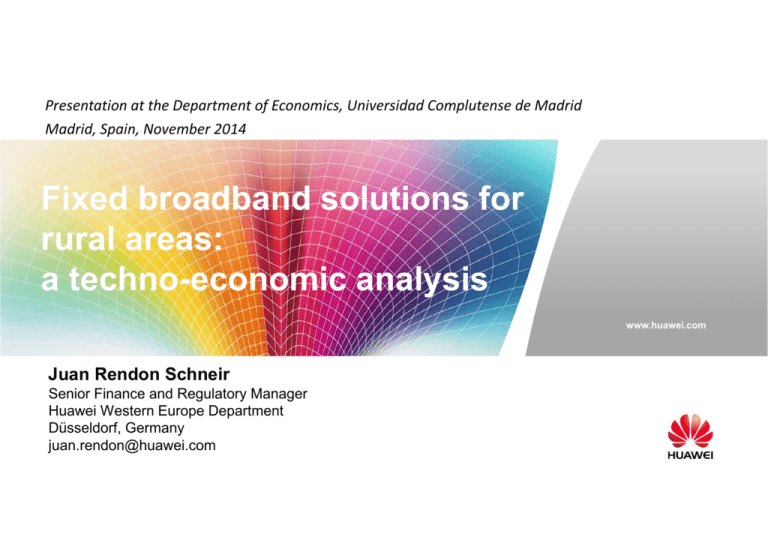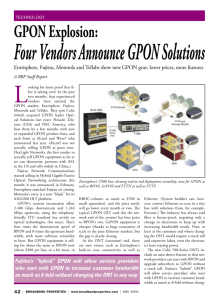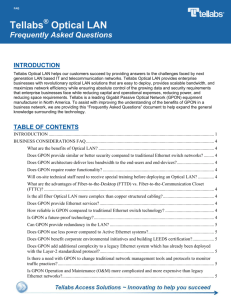
Presentation at the Department of Economics, Universidad Complutense de Madrid
Madrid, Spain, November 2014
Fixed broadband solutions for
rural areas:
a techno-economic analysis
www.huawei.com
Juan Rendon Schneir
Senior Finance and Regulatory Manager
Huawei Western Europe Department
Düsseldorf, Germany
juan.rendon@huawei.com
Content
• Introduction
• Network scenarios
• Costing methodology
• Results
• Conclusions
Commercial in Confidence
Page 2
Introduction
Status of NGA deployment in the European Union
Achievement of the Digital Agenda Targets (as of 2014)
Basic broadband for all by 2013: 100% in 2013 √ Mission accomplished!
Fast broadband (>30Mbps) for all by 2020: 62% in 2013 Not yet, but as of 2014 there are
6 years left.
Next Generation Access (NGA), >30Mbps, broadband coverage
in the EU, 2010-2013
100%
NGA networks and coverage:
• Cable Docsis 3.0 (41.2%)
• VDSL (31.2%)
• FTTP (14.5%)
80%
60%
40%
20%
Source: IHS,VVA and Point Topic
0%
2010
2011
2012
2013
Next Generation Access (NGA) covers 62%, but in
rural areas the penetration is low.
Source: European Commission, Digital Agenda Scoreboard 2014
Commercial in Confidence
Page 3
Introduction
Lack of NGA deployment in rural areas in Europe
Next Generation Access (FTTP, VDSL and Docsis 3.0 cable) coverage, 2013
100%
Total
Rural
90%
80%
70%
60%
50%
40%
30%
20%
10%
0%
IT
EL
HR
FR
PL
IE
SK
IS
EU
CZ
ES
RO
BG
AT
SE
FI
SI
EE
DE
NO
HU
CY
UK
DK
PT
LV
LU
LT
NL
BE
MT
Source: IHS and VVA
NGA rural coverage:18.1% (mostly through VDSL)
Source: European Commission, Digital Agenda Scoreboard 2014
Commercial in Confidence
Page 4
What is a rural area? Example of a village and its surroundings
• This is a
satellite
picture of
google maps
of a village in
Germany.
• The results
presented in
this study are
not based on
this specific
case.
In this case two
types of
households are
identified:
a) those that
are close to
the Central
Office
located in
the village
(in pink), and
b) those that
are far away
(in yellow)
Street Cabinet
Central Office
Street Cabinet
Street Cabinet
200 m
Commercial in Confidence
Page 5
Australian NBN Co: Importance of the cost analysis
Why 93% with fibre? The cost curve provides the answer
Fibre to the premises cost curve
• “The cumulative and marginal
cost curve of the fibre access
network ranges from 0 to 100%
coverage of premises in Australia.”
• It helps to understand “where it
becomes more dramatically more
expensive to service additional
premises”.
• “The cost curve demonstrates
that the incremental cost to
connect premises accelerates very
sharply after the 93rd percentile.”
Source: Australia NBN Implementation Study
Commercial in Confidence
Page 6
Australian NBN Co: Importance of the cost analysis
A mix of fibre, wireless and satellite networks
Cost comparison of alternative technologies in the final 10 percent
• “Government’s coverage
objective should be
interpreted as ensuring at
least 12Mbps peak data
rates are available to all
premises beyond the fibre
footprint.”
• “NBN Co should offer a
wholesale Ka-band satellite
broadband service
targeting the final 3% of
premises.”
• “A fixed wireless service
should provide coverage
between the 94th and 97th
percentiles.”
Source: Australia NBN Implementation Study
Commercial in Confidence
Page 7
Introduction
Motivation and Objectives
• In many cases NGA deployment in urban areas - and for a few suburban areas - can
be provided by means of competition. The business case in these areas is rather clear.
• As of 2014, there is very little deployment of NGA networks in rural areas.
• Policy makers and operators in Europe are examining different possibilities to
provide high-speed fixed broadband services in rural areas over the next years.
• This presentation examines the use of different NGA networks in rural areas.
• A techno-economic analysis of the following networks is provided:
• FTTC Vectoring
• FTTdP-Street G.fast
• FTTdP-Building G.fast
• FTTH GPON
Commercial in Confidence
Page 8
Content
• Introduction
• Network scenarios
• Costing methodology
• Results
• Conclusions
Commercial in Confidence
Page 9
Network architecture
FTTC Vectoring
• This is a reference architecture.
• No fault management system is considered in this architecture
ODF: Optical Distribution Frame
OLT: Optical Line Terminal
AGS: Aggregation Switch
MSAN: Multi-Service Access Node
CPE: Customer Premises Equipment
CPE
In-building
Segment
Twistedpair
CPE
Feeder
Segment
Central Office
Ethernet
port
Commercial in Confidence
Distribution
Drop
Segment
Segment
ODF
AGS
Operator’s
network
Street
Cabinet
GE
Fiber
MSAN
Copper
Page 10
Twistedpair
Network architecture
FTTdP-Street G.fast
• This is a reference architecture.
• No fault management system is considered in this architecture
CPE: Customer Premises Equipment
DPU: Distribution Point Unit
MDF: Main Distribution Frame
ODF: Optical Distribution Frame
OLT: Optical Line Terminal
RPF: Reverse Power Feeding
Feeder
Segment
OLT
Street
Cabinet
Distribution
Segment
Drop
Segment
Copper
ODF
MDF
DPU Cabinet
Operator’s
network
Ethernet
port
GPON
port
Commercial in Confidence
Splitter 1:8
Fiber
Copper
Fiber
Page 11
CPE
RPF
CPE
Copper
In-building
Segment
Central Office
RPF
Network architecture
FTTdP-Building G.fast
• This is a reference architecture.
• No fault management system is considered in this architecture
CPE: Customer Premises Equipment
DPU: Distribution Point Unit
MDF: Main Distribution Frame
ODF: Optical Distribution Frame
OLT: Optical Line Terminal
RPF: Reverse Power Feeding
Feeder
Segment
OLT
Street
Cabinet
Distribution
Segment
Drop
Segment
Copper
ODF
DPU Cabinet
Operator’s
network
Ethernet
port
GPON
port
MDF
Splitter 1:8
Fiber
Fiber
Copper
Commercial in Confidence
Page 12
CPE
RPF
CPE
Copper
In-building
Segment
Central Office
RPF
Network architecture
FTTH/GPON
• This is a reference architecture.
• No fault management system is considered in this architecture
CPE: Customer Premises Equipment
ODF: Optical Distribution Frame
ONT: Optical Network Terminal
OLT: Optical Line Terminal
ONT
Fiber
In-building
Segment
ONT
Feeder
Segment
Central Office
OLT
Operator’s
network
Ethernet
port
Street
Cabinet
Distribution
Segment
Drop
Segment
Fiber
ODF
GPON
port
Commercial in Confidence
Splitter 1:4
Splitter 1:8
Fiber
Fiber
Page 13
CPE
CPE
Content
• Introduction
• Network scenarios
• Costing methodology
• Results
• Conclusions
Commercial in Confidence
Page 14
Assumptions for the average rural area
Item
Value
Total number of subscribers per Central
Office
3,000
Average feeder segment length
2,500 m
Average distribution segment length
220 m
Average drop segment length
26 m
Number of households per building
5
Time period for the analysis
15 years
• These values are not based on the example of a rural area shown in the previous slide.
Commercial in Confidence
Page 15
Type of results presented in the study
1) Homes Passed
2) Homes Connected
CAPEX/OPEX?
Market Share
Effect of churn rate
on the number of
subscribers?
only CAPEX
100%
No
CAPEX and OPEX
50%
Yes
CAPEX:
• Material and installation of equipment (Homes Passed and Homes Connected)
• Connection works of a new user (Homes connected)
OPEX:
• Maintenance of the equipment (Homes connected)
GREENFIELD APPROACH:
Feeder and Distribution segments: The ducts in the feeder and distribution segment should be
deployed.
Commercial in Confidence
Page 16
Content
• Introduction
• Network scenarios
• Costing methodology
• Results
• Conclusions
Commercial in Confidence
Page 17
Set of Results
• Cost per Home Passed, CAPEX only, 100% market share
• Cost per Home Connected, CAPEX and OPEX, 50% market share
• Techno-economic comparison
Commercial in Confidence
Page 18
Rural Area
Cost Per Home Passed: CAPEX only, 100% market share
Cost Reductions
achieved vs. FTTH:
• FTTdP-Building G.fast: 0%
• FTTdP-Street G.fast: 13%
• FTTC-Vectoring: 60%
Commercial in Confidence
Page 19
Cost per Home Connected, CAPEX and OPEX, 50% market share:
Time period: 15 years. It includes the effect of the churn rate (10%). Rural area
Cost Reductions
achieved vs. FTTH:
• FTTdP-Building G.fast: 1%
• FTTdP-Street G.fast: 9 %
• FTTC-Vectoring: 55 %
Commercial in Confidence
Page 20
Rural area
Techno – economic comparison
Network type
Theoretical transmission capacity
(Cost per home connected, 50% market
share)
FTTC-Vectoring
[100 Mbps] (distance of 250 m)
(1,876 €)
FTTdP-Street G.fast
[80-100 Mbps] (GPON splitting ratio of 32)
(3,776 €)
FTTdP-Building G.fast
[80-100 Mbps] (GPON splitting ratio of 32)
(4,143 €)
FTTH GPON
[80-100 Mbps] (GPON splitting ratio of 32)
(4,165 €)
Commercial in Confidence
Page 21
Content
• Introduction
• Network scenarios
• Costing methodology
• Results
• Conclusions
Commercial in Confidence
Page 22
Conclusions
•
In rural areas, the cost of FTTC-Vectoring is lower than the cost of the
other networks described (FTTH and FTTdP G.fast)
•
The cost of FTTdP G.fast is lower than the cost of FTTH.
•
The question that operators and policy makers will ask is: which
broadband capacity should be provided?
•
More rural scenarios will be studied to understand better the technical
and cost implications of fixed broadband access networks.
Commercial in Confidence
Page 23
Thank You
www.huawei.com
Copyright©2013 Huawei Technologies Co., Ltd. All Rights Reserved.
The information in this document may contain predictive statements including, without limitation, statements regarding the future financial
and operating results, future product portfolio, new technology, etc. There are a number of factors that could cause actual results and
developments to differ materially from those expressed or implied in the predictive statements. Therefore, such information is provided for
reference purpose only and constitutes neither an offer nor an acceptance. Huawei may change the information at any time without notice.









